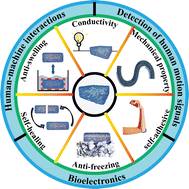Functional conductive hydrogels: from performance to flexible sensor applications
Abstract
Due to the good biocompatibility and easy regulation of hydrogels, hydrogel-based flexible sensors have flourished in the fields of wearable electronics, electronic skin, and soft robotics in recent years. The performance of conductive hydrogel-based sensors is greatly influenced by the properties of hydrogel functional materials. This review focuses on and summarizes the preparation strategies and general methods of functional conductive hydrogels for flexible sensors. Firstly, the general properties and improvement methods of conductive hydrogels are briefly introduced, mainly including electrical conductivity and mechanical properties. In practical applications, some additional functions that enable conductive hydrogel-based sensors to maintain excellent performance in the face of complex or harsh application conditions are indispensable. The strategies for endowing conductive hydrogels with additional functions mainly including self-healing properties, anti-swelling properties, anti-freezing properties, and self-adhesion properties are summarized in this review. The application of functional conductive hydrogels in flexible sensors, as well as the development prospects and challenges based on functional conductive hydrogels are discussed in detail.

- This article is part of the themed collections: 2023 Materials Chemistry Frontiers Review-type Articles and 2023 Materials Chemistry Frontiers HOT articles


 Please wait while we load your content...
Please wait while we load your content...